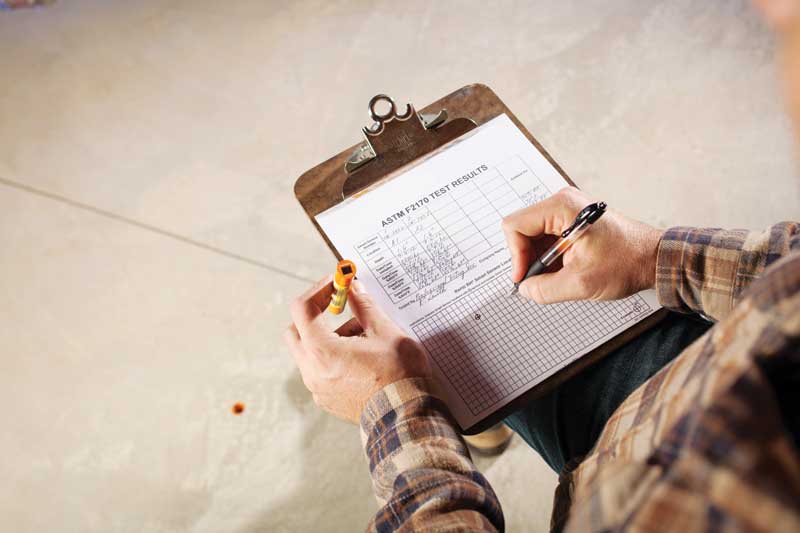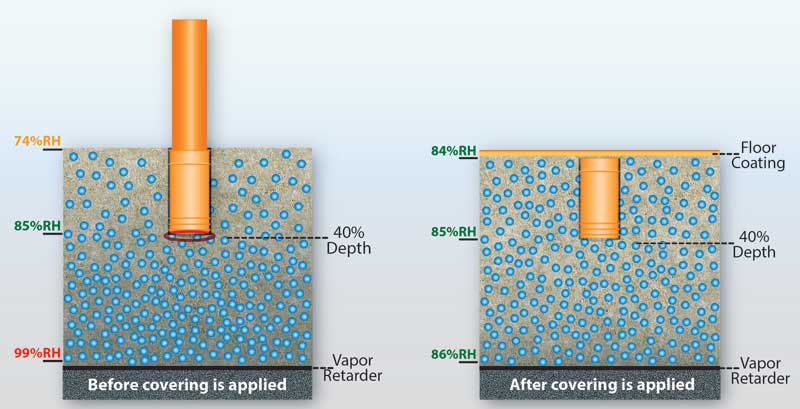
Images courtesy Wagner Meters
Mat bond test
This test uses a 1-m (3-ft) square of flooring adhered to the concrete slab to evaluate the bond. However, in real jobsite conditions, the test usually cannot be left in place long enough to evaluate the flooring’s long-term performance once the moisture gradient in the slab has equilibrated. If the flooring does not bond well, or if the adhesive breaks down during the test, it can be concluded the moisture condition in the concrete is too high. However, the reverse is not necessarily true. A passing test result may entirely overlook a deep-seated, high-moisture condition.
Both the plastic sheet test and the mat bond test are qualitative tests that can indicate when substantial moisture is present in concrete subfloors, but they should not be relied on to show the moisture level in the concrete is acceptable.
Handheld meters
There are handheld electrical resistance and impedance meters designed to read moisture in a shallow region, roughly the top 25 mm (1 in.) of the concrete. Following ASTM F2659, Standard Guide for Preliminary Evaluation of Comparative Moisture Condition of Concrete, Gypsum Cement and Other Floor Slabs and Screeds Using a Non-destructive Electronic Moisture Meter, these devices have relative scales that can provide a qualitative assessment of the concrete surface’s moisture condition.
However, there are several factors that can impact the electrical resistance and impedance, including the type of aggregate used in the concrete, the degree of hydration in the cement paste, and the presence of steel reinforcement or wire mesh. Therefore, this testing option only offers a potential indication of moisture. It also provides a numeric result on a relative scale only, rather than a true quantitative measurement of the moisture condition. Additionally, because this method only takes measurements at or near the slab’s surface, it has many of the same drawbacks as the CaCl2 test.
ASTM F2170 RH testing inside the concrete slab
The in-situ RH test provides a numeric measurement of the moisture within a concrete slab using an RH sensor placed at a specific depth. Scientific research conducted over many years at Lund University in Sweden determined that RH sensors, when installed at a depth of 40 percent of a slab drying from one side (or 20 percent depth when drying from two sides), provide test results correlating well with the slab’s moisture condition after floorcovering installation. As such, this method provides a useful, reliable indication of the moisture within the slab that will be available to interact with and potentially affect floorcoverings and adhesives.

The in-situ RH method carries a number of significant advantages:
1. The test provides a measurement of the equilibrium moisture level, which is the moisture condition that an adhesive or floorcovering actually experiences after installation. This makes the RH test an especially useful predictive tool regarding the finished floor’s long-term performance.
2. By measuring the RH at 40 percent depth, the test also provides a measurement of moisture much less vulnerable to changing ambient conditions outside the slab.
3. RH probes can be used in conjunction with electronic devices capable of recording the changes in RH within a slab over time. This is helpful in predicting how long it might take a floor slab to reach an acceptable moisture level.
4. Many flooring and adhesive manufacturers have conducted testing and established specific RH limits for their products. These limits, when matched with the actual numeric test results obtained in the field, make it very easy to determine the appropriate time to install specific flooring products and adhesives.
5. ASTM F2170, the in-situ RH test, has been shown to be an extremely fast, easy, and economical method to apply in the field. Not only does the method have a strong scientific pedigree that supports making important project decisions with confidence, but it also typically saves time and money while conducting the moisture test itself.
As Figure 3 indicates, the RH test described in ASTM F2170 is recognized and used worldwide, while the CaCl2 test is employed only in the United States. No other country in the world recognizes the CaCl2 method as a viable option for concrete moisture measurement. In fact, even in the United States, limitations are now placed on its use. The ASTM standard no longer allows ASTM F1869 to be used in certain applications, such as for lightweight concrete.




